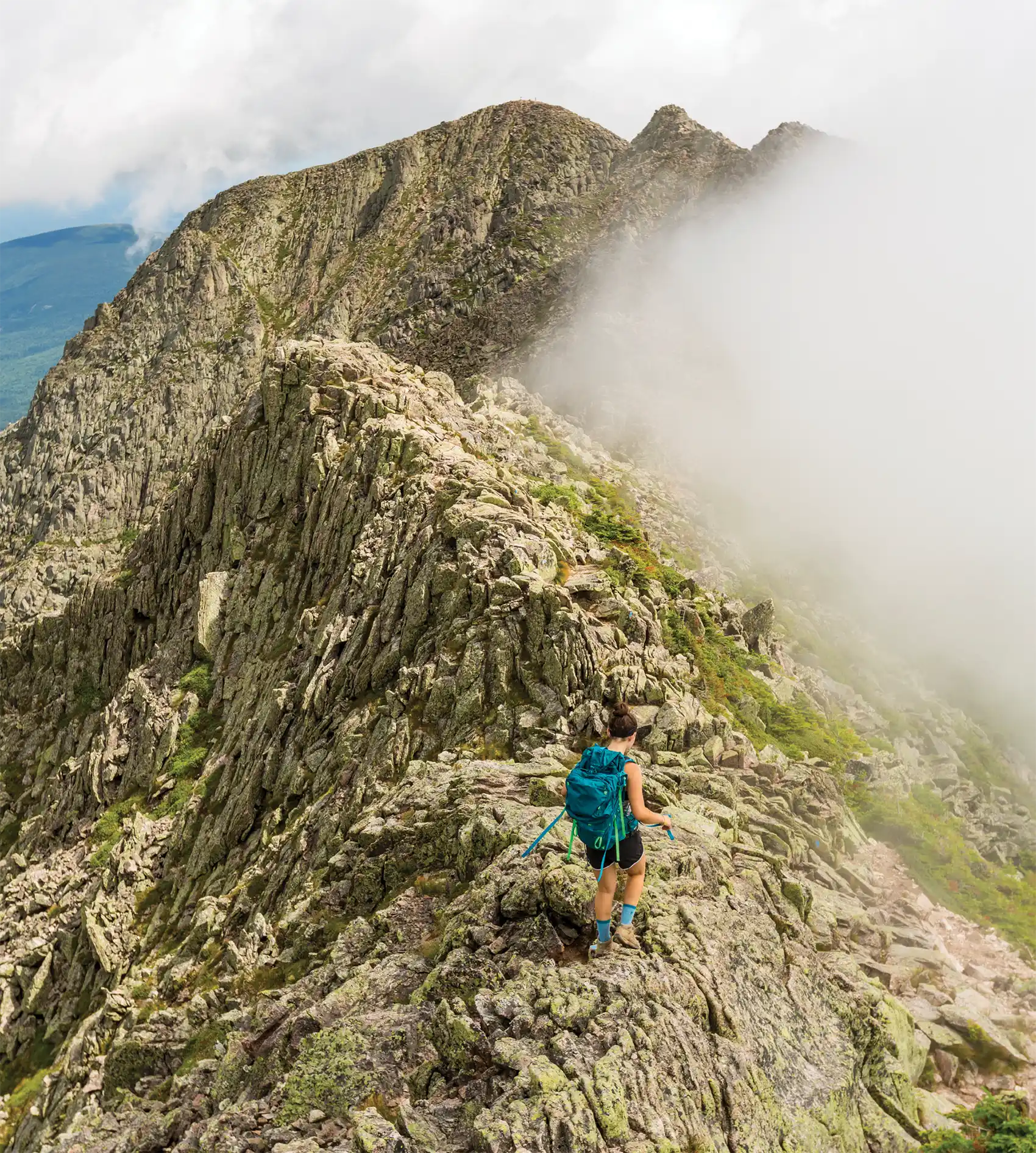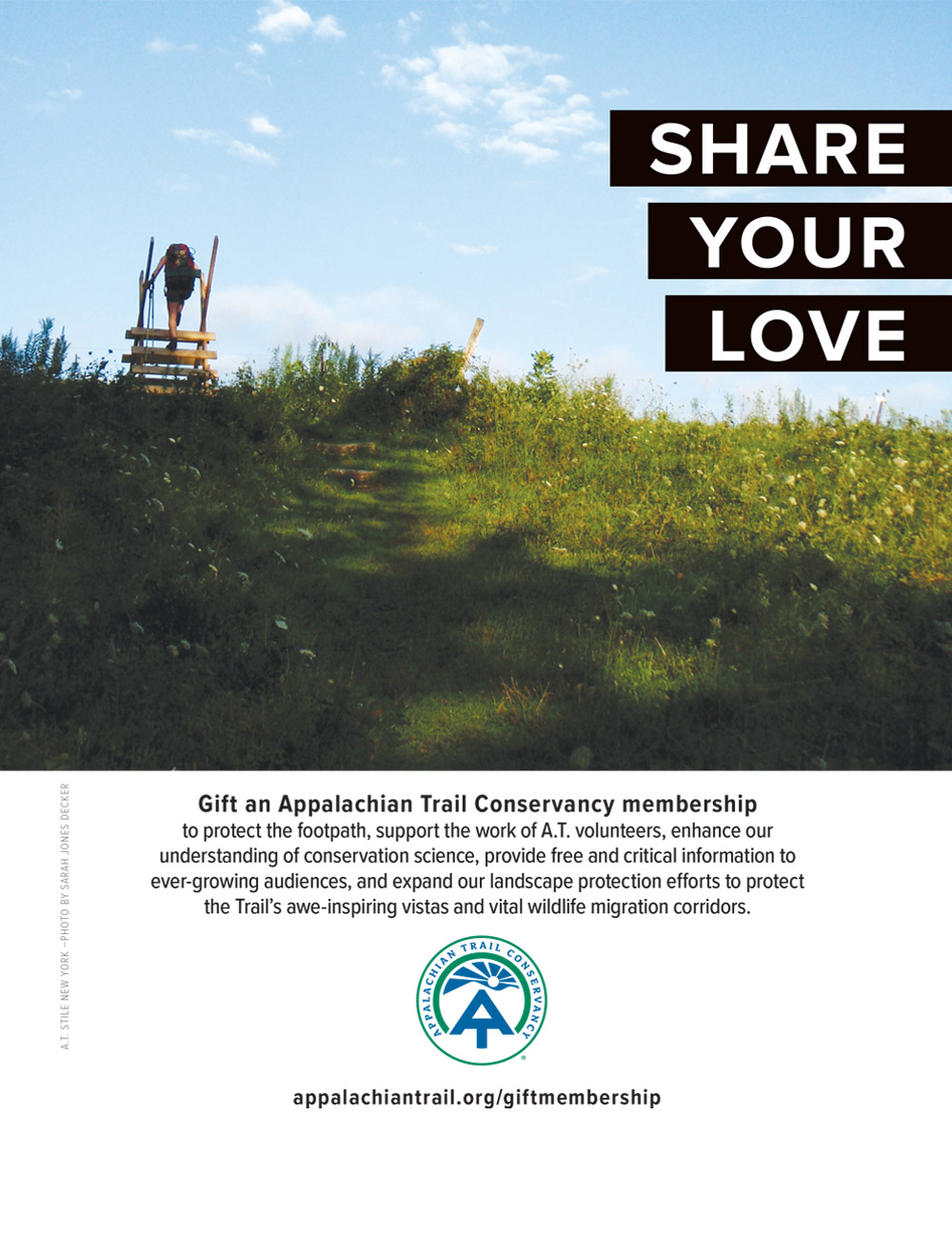A hiker traverses Knife Edge on Katahdin. Although not officially part of the Appalachian Trail, this iconic ridge is one of many components of the A.T. landscape that make it both memorable and scenic. Learn more about the ATC’s work to document scenic vistas visible from the Trail here.
Photo by Jeffrey Monkman
A hiker traverses Knife Edge on Katahdin. Although not officially part of the Appalachian Trail, this iconic ridge is one of many components of the A.T. landscape that make it both memorable and scenic. Learn more about the ATC’s work to document scenic vistas visible from the Trail here.
Photo by Jeffrey Monkman

ATC Executive Leadership
Sandra Marra / President & CEO
Nicole Prorock / Chief Financial Officer
Laura Belleville / Vice President of Conservation and Policy
Hawk Metheny / Vice President of Regional and Trail Operations
Lisa Zaid / Vice President of Advancement
A.T. Journeys
Anne Merrill / Associate Vice President of Advancement
Traci Anfuso-Young / Art Director / Designer
A.T. Journeys is published on matte paper manufactured by Sappi North America mills and distributors that follow responsible forestry practices. It is printed with Soy Seal certified ink in the U.S.A. by Sheridan NH in Hanover, New Hampshire.
A.T. Journeys ( ISSN 1556-2751) is published by the Appalachian Trail Conservancy, 799 Washington Street, Harpers Ferry, WV 25425, (304) 535-6331. Bulk-rate postage paid at Harpers Ferry, West Virginia, and other offices. Postmaster: Send change-of-address Form 3575 to A.T. Journeys, P.O. Box 807, Harpers Ferry, WV 25425.
MISSION
The Appalachian Trail Conservancy’s mission is to protect, manage, and advocate for the Appalachian National Scenic Trail.
Board of Directors
Colin P. Beasley / Chair
Robert E. Hutchinson, Jr. / Vice Chair
James LaTorre / Secretary
Patricia Shannon / Treasurer
Daniel A. Howe / Chair, Stewardship Council
Sandra Marra / President & CEO
Grant L. Davies
Rita Hennessy
John W. Knapp, Jr.
Yong Lee
Colleen Peterson
Eboni Preston
Nathan G. Rogers
Katherine Ross
Rajinder Singh
Jeri Ward
Greg Winchester
Nicole Wooten
A.T. Journeys is published on matte paper manufactured by Sappi North America mills and distributors that follow responsible forestry practices. It is printed with Soy Seal certified ink in the U.S.A. by Sheridan NH in Hanover, New Hampshire.
A.T. Journeys ( ISSN 1556-2751) is published by the Appalachian Trail Conservancy, 799 Washington Street, Harpers Ferry, WV 25425, (304) 535-6331. Bulk-rate postage paid at Harpers Ferry, West Virginia, and other offices. Postmaster: Send change-of-address Form 3575 to A.T. Journeys, P.O. Box 807, Harpers Ferry, WV 25425.
Standing on an overlook taking in the views, you might find yourself in full conversation with the stranger next to you. “Is this your first time here? How far are you hiking? Is there a big climb ahead for me?” The rules that keep us from speaking to folks we pass on city sidewalks, stand with on subway platforms, and share space with on elevators do not hold for us when we are on the A.T. As much as the Trail brings opportunity for solitude in nature, it also allows us the space to build relationships, however fleeting, with other humans that we otherwise would never know.
highlights / events

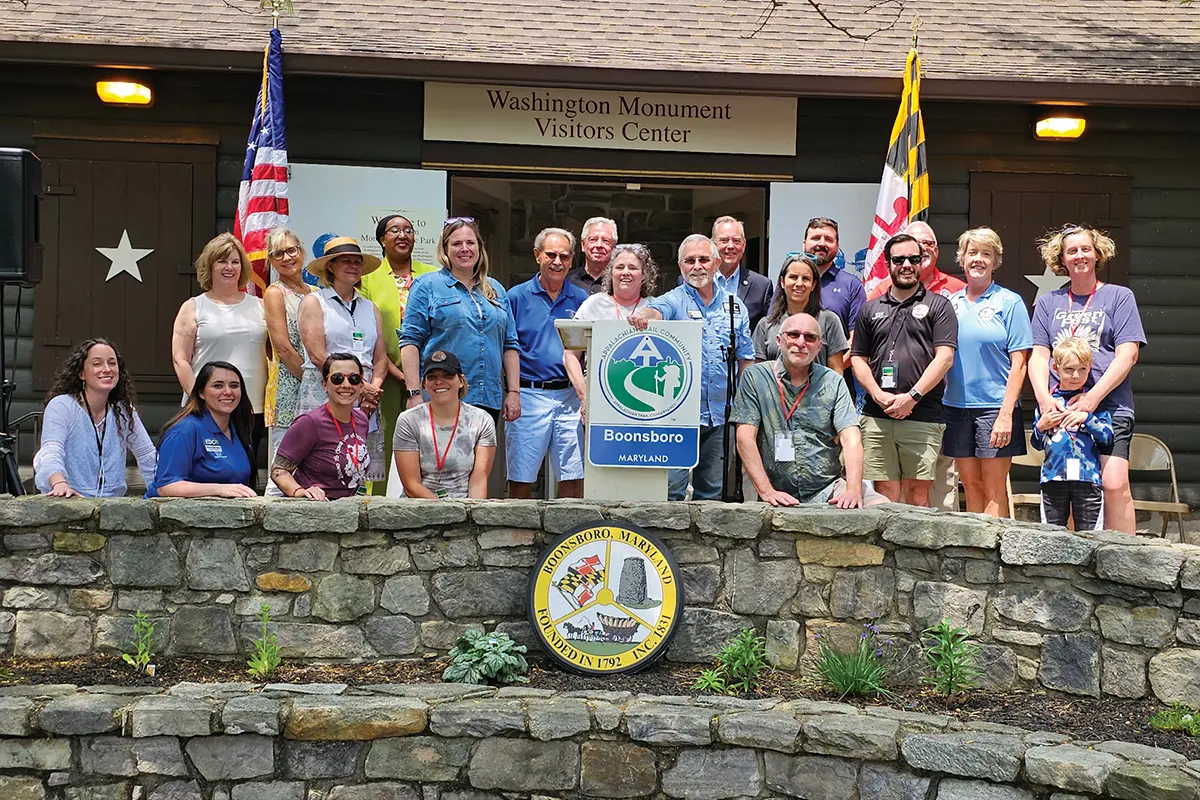
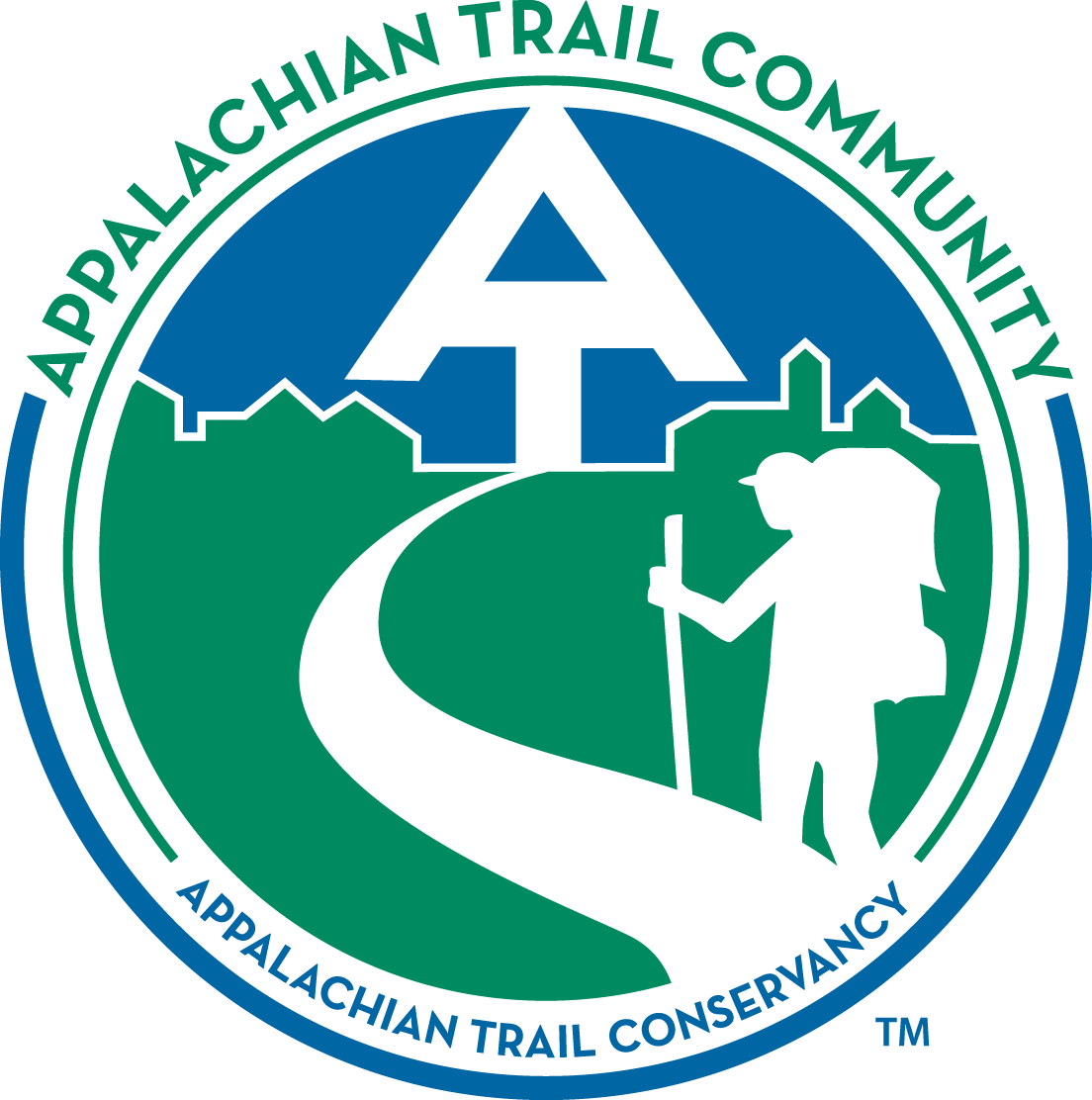
The A.T. Community™ Program was established in 2009 to assist rural communities along the Appalachian Trail with sustainable economic development through tourism and outdoor recreation. To be eligible for the program, communities commit to environmental stewardship through volunteerism, community-led conservation, and support for outdoor recreation economies. Located near the Trail, the communities serve as gateways — they are often the first stop for Trail visitors on their way to a hike, birding adventure, or family outing.
After becoming an official A.T. Community, towns along the Trail typically benefit from increased tourism, economic growth, community engagement, and environmental stewardship. “Successful communities see their events and volunteer opportunities expand,” said Katie Allen, director of landscape conservation at the ATC. “Increased community commitment to environmental stewardship helps protect the unique sense of place that community residents enjoy as great places to live, work, and play.”
Towns seeking to join the A.T. Community™ Program undertake a multi-step process that includes establishing an advisory committee of community representatives and submitting an application and letters of support. The materials are reviewed by representatives of the ATC and local partners — including Trail maintaining clubs and land managers — to ensure the community’s level of commitment and readiness to promote and protect the Appalachian Trail.
The annual meeting is an opportunity to come together as a community to discuss the future of the ATC and recommit to educating and empowering current and future caretakers of the Appalachian Trail (A.T.).
The results of the 2023 Board of Directors election will be announced at the meeting. The slate of candidates will be published on the ATC website in late July, and all members whose membership is current as of August 1, 2023, are eligible to vote. Members will receive an email to cast their ballot online.
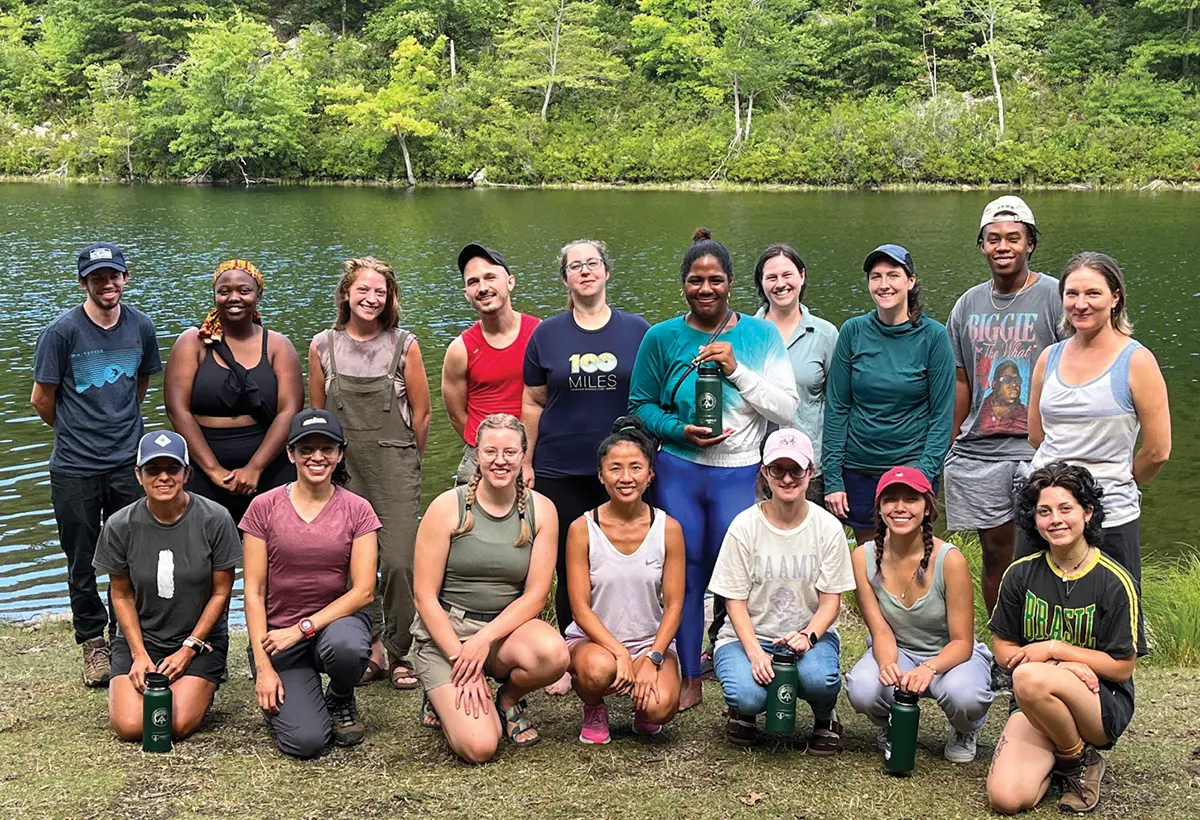
Participants attend for a variety of reasons, but many relate to a desire to establish community. One participant in the 2022 summit looked to “connect with like-minded folks who share the same intentions of building an inclusive community… inviting people of all different backgrounds to get involved in the outdoors and conservation efforts.” Another aimed to “share [their] passion for accessibility and sustainability of the outdoors.” For most, the summit marked the first time they had set foot on the Appalachian Trail.

A.T. Journeys: Why did you decide to pursue a career in the environmental field?
Briggs: For me there is nothing more important than working to ensure that our environment endures for generations to come. I entered the Marine Corps after completing my undergraduate degree at Purdue University Northwest. I have always felt that I should be using my time to help make sure the world remains hospitable to life as far into the future as possible. In a day and age when our knowledge and understanding of threats to the environment are at an all-time high, I think we have an opportunity and an obligation to make wiser choices towards the preservation of Earth and all the species that call it home.
ATJ: What kind of environmental education did you have prior to graduate school?
Briggs: I started learning about animals in first or second grade after noticing and catching toads in my backyard in Gary, Indiana. From that early experience interacting with wild animals, I dove deeply into animal documentaries and books and the library. I enjoyed watching Steve Irwin and Jeff Corwin, to name a couple of individuals who come to mind. As I digested whatever facts I could about animals in different parts of the world, I also gained an understanding of factors that threaten their survival — things like habitat loss, deforestation, urban development, and other phenomena.
ATJ: What are you focused on during your internship with the ATC?
Briggs: I am helping create new and diverse connections between the ATC, businesses, organizations, and visitors. I am currently reaching out to establishments that fall in the outdoors realm to see what kind of educational opportunities we can collaborate on to encourage better visitor stewardship of the Trail. In addition, I am hosting a camping trip at Harpers Ferry to expose some of my fellow African American friends to the outdoors.
ATJ: Why do you think it’s important for people to have access to outdoor spaces like the Appalachian Trail?
Briggs: Outdoor experiences shape our perception of the environment in which we live as well as our values. People need to value Earth’s natural ecosystems to the point of making conscious decisions to protect them. We as individuals tend to ignore or waste what we don’t appreciate. People need access to outdoor spaces to be reminded that we are inseparably connected to the natural world that makes all life possible.
ATJ: What do you consider the biggest challenge to the sustainability of public lands like the A.T.?
Briggs: The biggest challenge is the lack of diverse exposure to these spaces. It becomes harder and harder to sustain public lands like the A.T. when people have little understanding of what they are and why they matter. Education and exposure are the keys to longevity for the A.T.
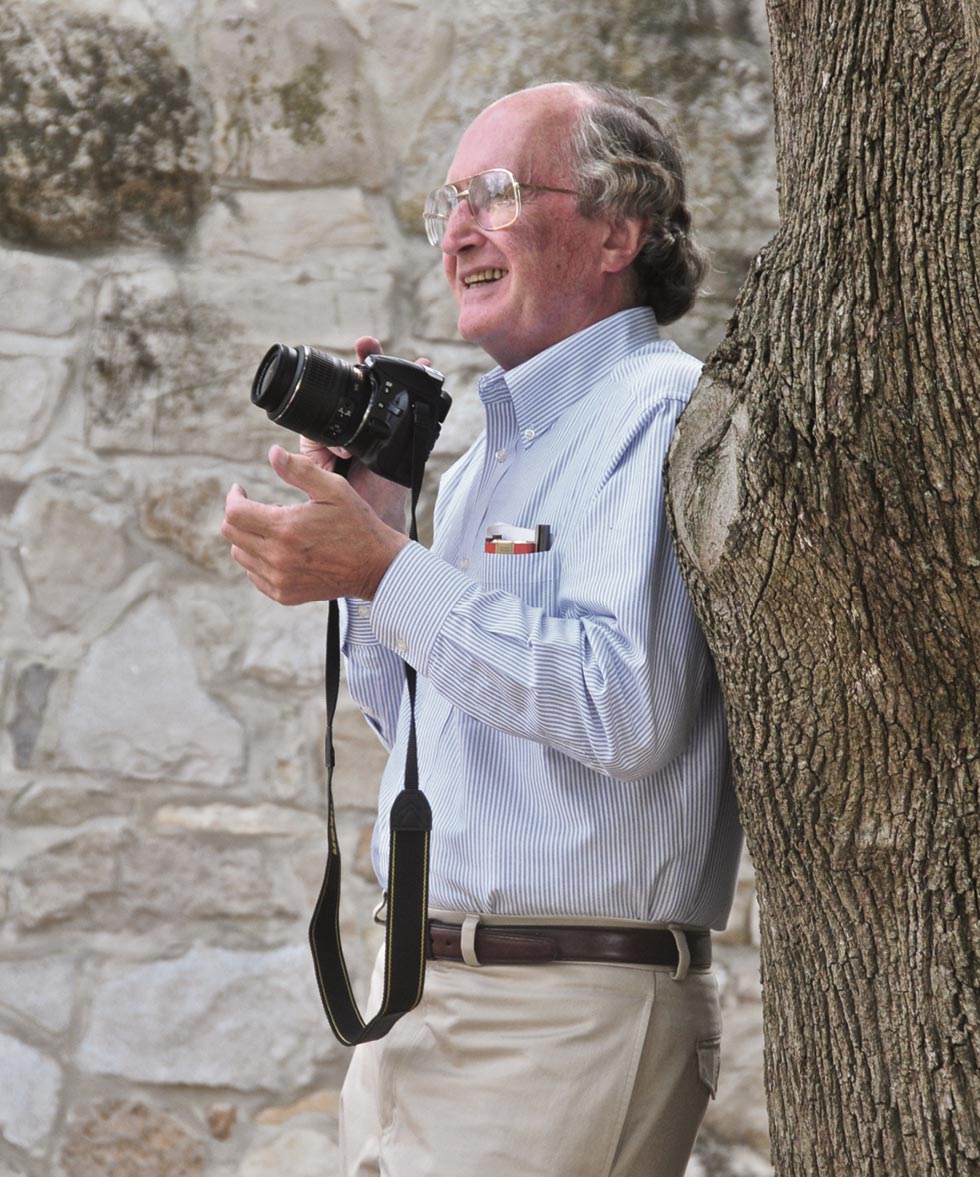
The A.T. Museum announced this spring that Brian B. King, who served as publisher at the ATC for 17 years, will be inducted into its Hall of Fame at an event on September 10, 2023. Prior to serving as publisher, King was the ATC’s director of public affairs. Throughout his career, he was the publisher or senior editor of 143 editions of 20 books, as well as the producer of 35 calendars and 30 catalogues each for consumer and wholesale audiences.
King joins a handful of former ATC staff to be recognized by the A.T. Museum for their exceptional and positive contributions to the Appalachian Trail or the A.T. community. Last year, Laurie Potteiger was inducted into the Hall of Fame in appreciation for her longtime service as the ATC’s information services manager.
King’s service to the ATC dates back to 1979, when he worked as a freelance assistant editor of the Appalachian Trailway News and as a volunteer on the board’s public-relations committee. A Board of Directors resolution upon his retirement in June 2022 summarized his contributions: “Brian has worked tirelessly to promote the value of public lands and the Appalachian National Scenic Trail to Appalachian Trail Conservancy members, volunteers, educators, communities, hikers, staff, and partners.”
The induction ceremony will begin at 1 p.m. on September 10 at Army Heritage Education Center in Carlisle, Pennsylvania. The ATC’s vice president of trail operations, Hawk Metheny, will serve as em-cee.

The A.T. Museum announced this spring that Brian B. King, who served as publisher at the ATC for 17 years, will be inducted into its Hall of Fame at an event on September 10, 2023. Prior to serving as publisher, King was the ATC’s director of public affairs. Throughout his career, he was the publisher or senior editor of 143 editions of 20 books, as well as the producer of 35 calendars and 30 catalogues each for consumer and wholesale audiences.
King joins a handful of former ATC staff to be recognized by the A.T. Museum for their exceptional and positive contributions to the Appalachian Trail or the A.T. community. Last year, Laurie Potteiger was inducted into the Hall of Fame in appreciation for her longtime service as the ATC’s information services manager.
King’s service to the ATC dates back to 1979, when he worked as a freelance assistant editor of the Appalachian Trailway News and as a volunteer on the board’s public-relations committee. A Board of Directors resolution upon his retirement in June 2022 summarized his contributions: “Brian has worked tirelessly to promote the value of public lands and the Appalachian National Scenic Trail to Appalachian Trail Conservancy members, volunteers, educators, communities, hikers, staff, and partners.”
The induction ceremony will begin at 1 p.m. on September 10 at Army Heritage Education Center in Carlisle, Pennsylvania. The ATC’s vice president of trail operations, Hawk Metheny, will serve as em-cee.
Appalachian Focus
THE RELATIONSHIP THAT WE AS HUMANS have to the landscape we traverse can be hard to appreciate fully at trail level. That is, until we confront a vista where sky, mountains, and water meet. Only then do we grasp that we are part of an interconnected whole that is much larger than our human scale.
Photo by Jerry Monkman from Moxie Bald Mountain, Maine. ecophotography.com
spotlight
DEEP
CONNECTIONS
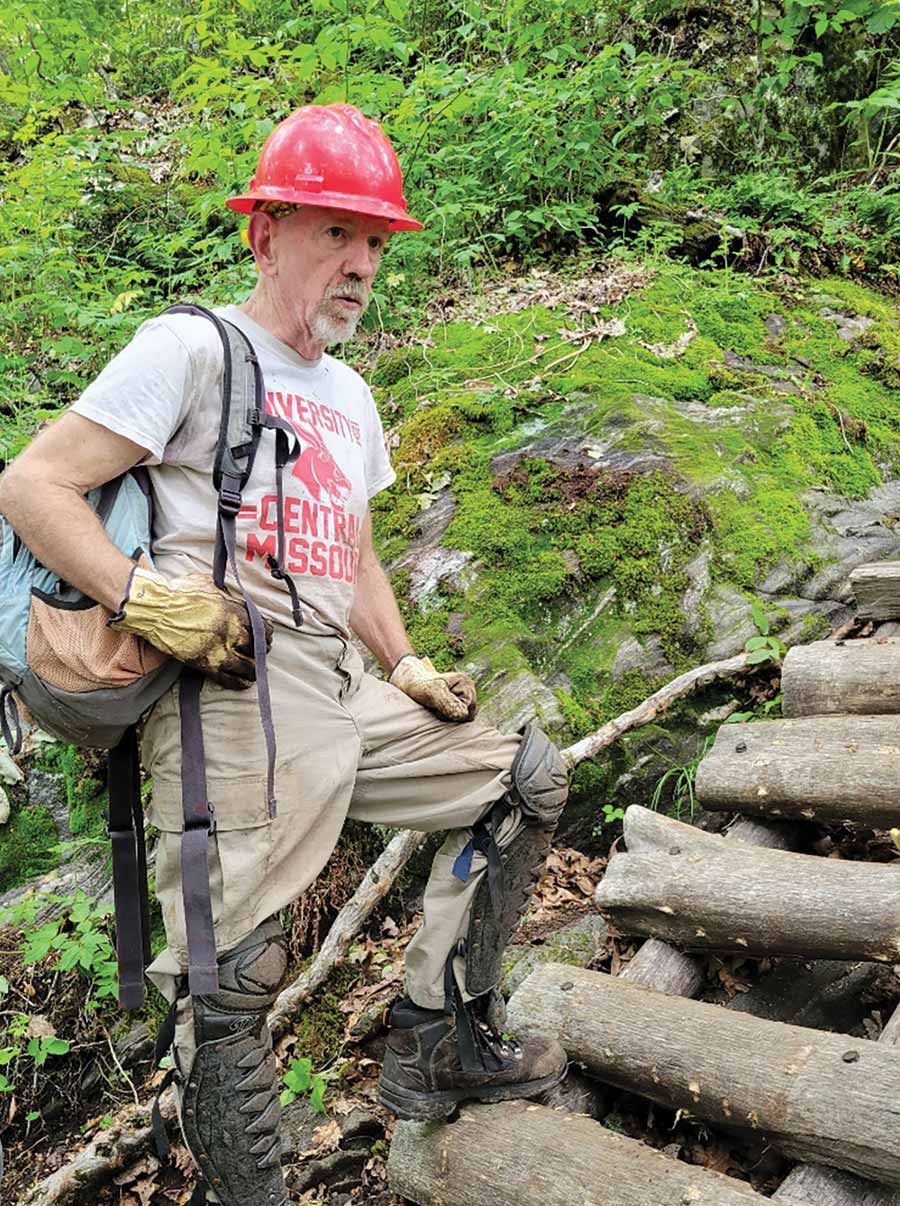
Background: A trip to the Great Smoky Mountains National Park, which gets its name from the foggy haze shown here, inspired Matt Perrenod’s lifelong love of the Appalachian Trail. Photo by Ed Tobin. Foreground, inset: Matt Perrenod volunteers frequently with the ATC’s Konnarock Trail Crew on the southern portion of the A.T. Photo courtesy of Ruth Mosholder.
The Appalachian Trail has been part of Matt Perrenod’s life since the late 1960s, when his father took him camping in Great Smoky Mountains National Park. Matt was just 10 years old, but he remembers clearly what it was like to hike up to Russell Field Shelter, which is located right along the Trail at an elevation of 4,360 feet. As Matt stood outside the shelter — which he recalls as being enormous in his 10-year-old eyes — his father pointed up and down the Trail, explaining that one way led hikers north toward Maine and the other way took people south to Georgia.
“At that time, I didn’t fully appreciate what 2,000 miles of Trail really was, but it was a big deal in my little mind,” Matt said.
This first experience on the Trail and the sense of wonder that came with it was the beginning of a life full of outdoor adventure and exploration for Matt, who fully embraced backpacking during his time as a Boy Scout.
“Although the Appalachian Trail didn’t occupy as much space in my mind then, the whole idea of being out backpacking — and moving from place to place and living your life out there — was such a basic and rewarding feeling,” he said.


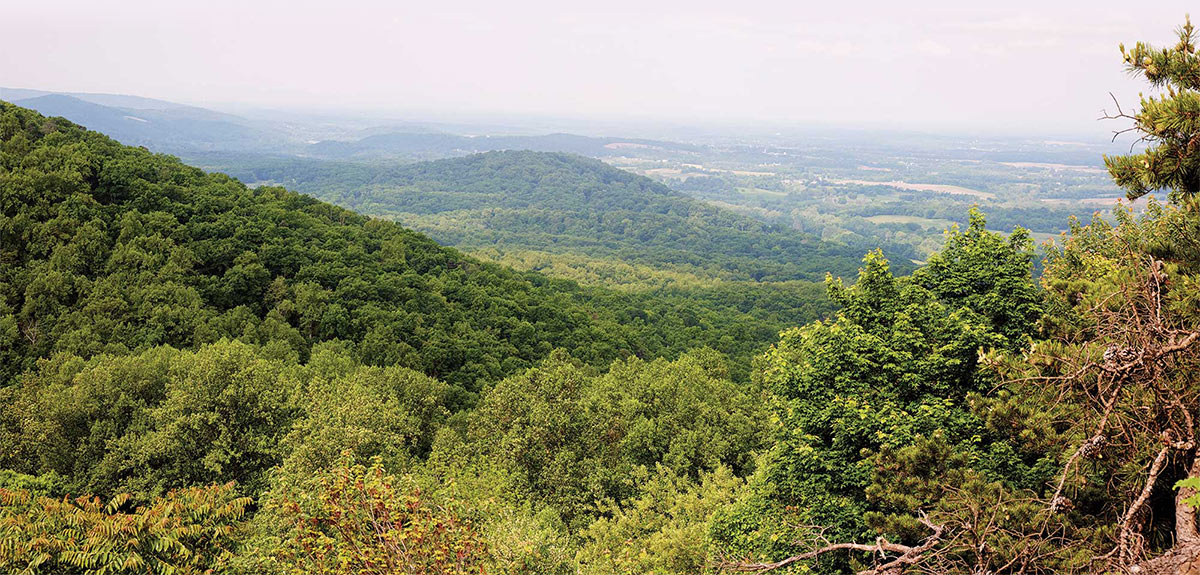
Listening in to their conversation, you might be struck by how similar it is to the discussion an art historian or critic might have about a work of art. Team members mention focal points, color and texture, forms, lines, balance, and symmetry. They ask one another: Is the viewscape vibrant and colorful? Does the foreground overpower the view of the landscape further from the Trail? Does the viewed landscape include a wide range of the features one would expect for this region?
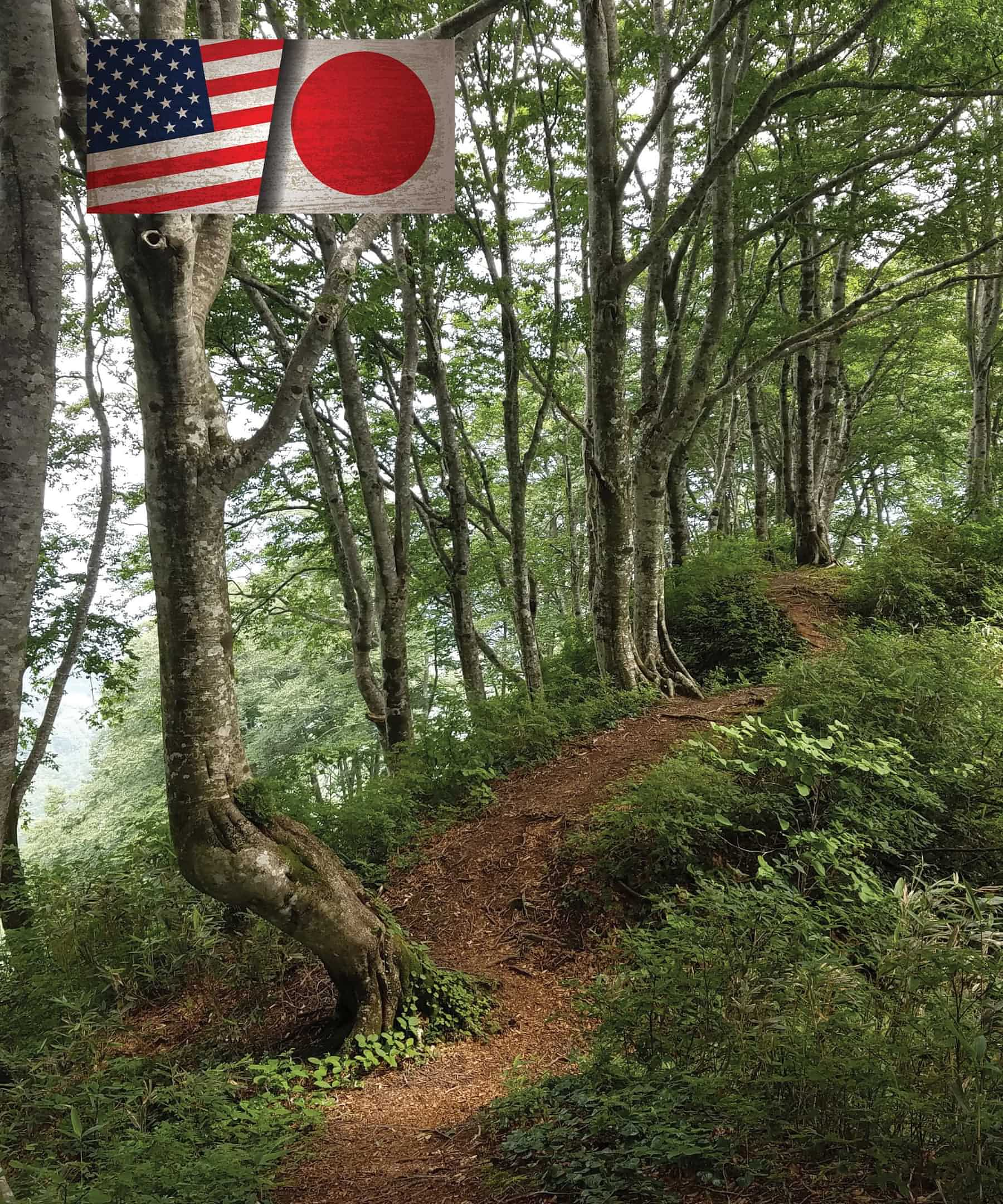
A portion of the Shinetsu Trail through a beech tree forest. Photo by Sarah Adams.
From America to Japan:
the Shinetsu Trail

Despite being separated by 10,000 miles and the world’s largest ocean, the Appalachian Trail and the Shinetsu Trail in Japan are inextricably connected. From their origins and purpose to the ways in which they are currently managed, the two trails have a surprising amount in common.
Nationwide, and especially in the crowded cities of the Northeast, people were waking up to the restorative benefits of time in nature. MacKaye described these as opportunities for both recreation and recuperation — activities that could engender a new perspective on the drudgery of daily life.

My little hiking group has been meeting once a month for the last three years. During the early months of the pandemic, I remember the feeling of isolation becoming more prevalent in our lives as our small rural circles began to feel even smaller. I started a Facebook hiking group to reconnect and get local friends out on the Trail. The A.T. runs over 70 miles along our county line in North Carolina, spanning two iconic locations from Max Patch to Big Bald. Being out on the Trail every month became the social and therapeutic outlet we didn’t know we collectively needed so badly in our busy lives.
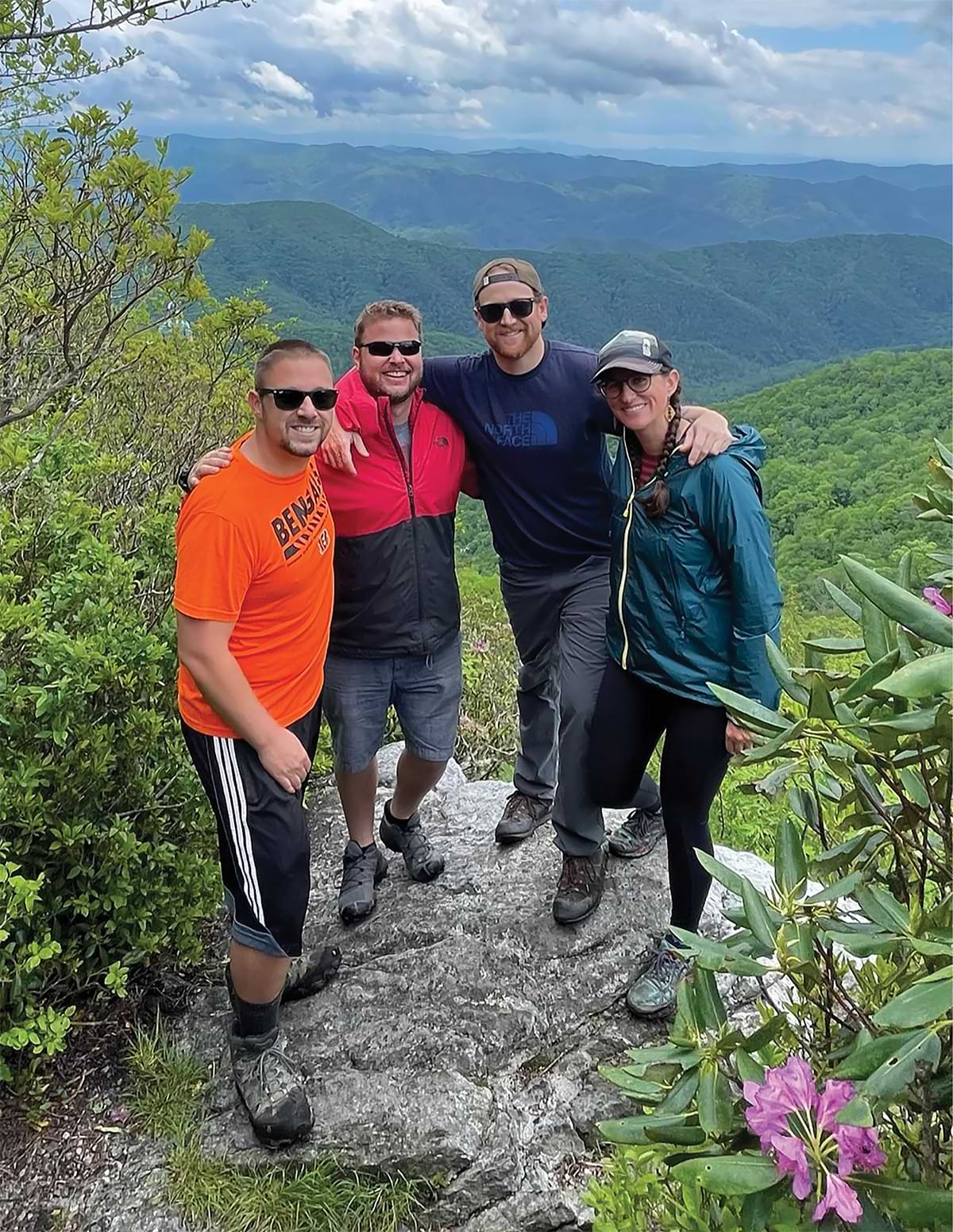
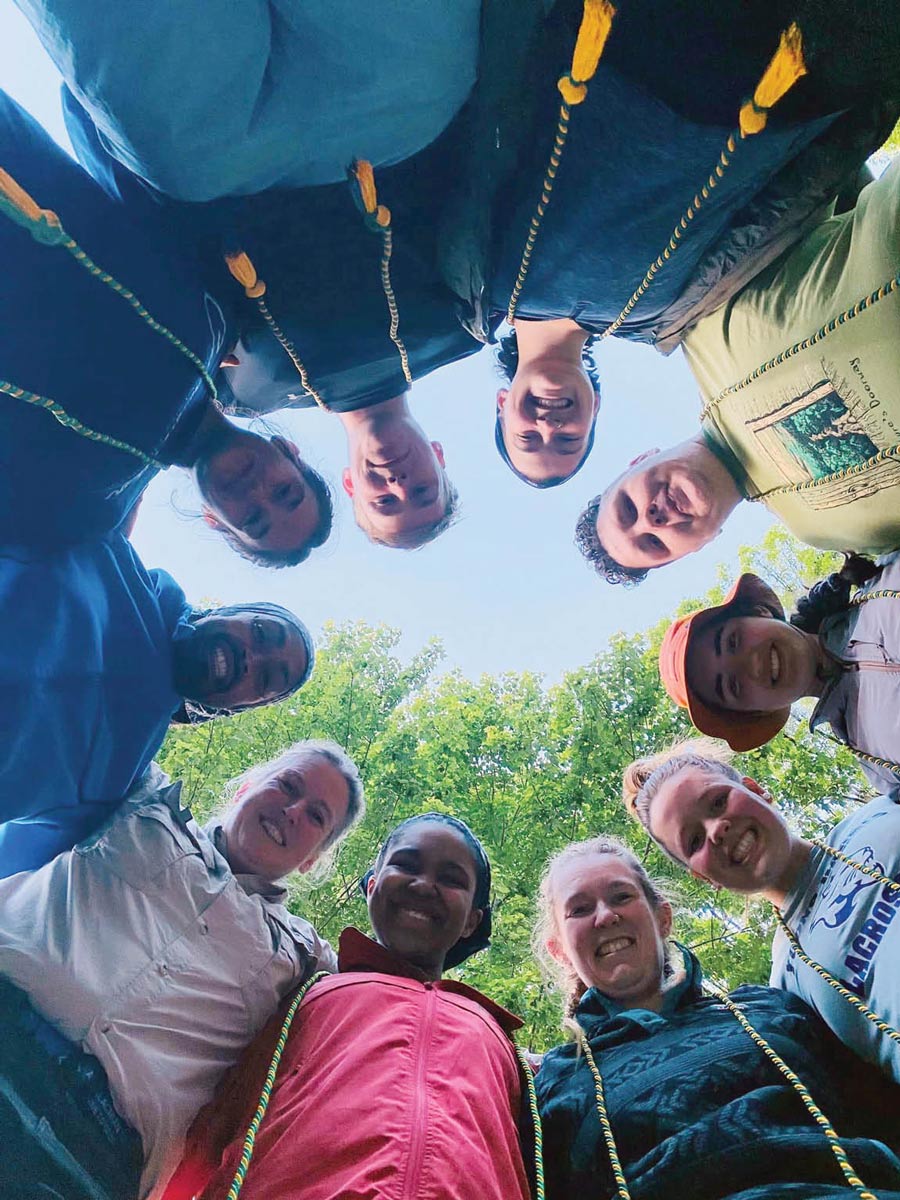
Morton visited Springer Mountain, Georgia, at the end of May 2023 with seven other college students from across the country — including me. We were participating in Partners in the Parks, an outdoor experiential learning program coordinated by the National Collegiate Honors Council. This year, honors students participated in weeklong hands-on educational programs in Mammoth Cave National Park, Missouri National Recreational River, New River Gorge National Park, Glacier National Park and the Appalachian Trail.
The A.T. has been a frequent host site for Partners in the Parks, and several ATC staff members have led educational workshops for participants over the years.
for the A.T.’s
Northern Terminus
“A group of us are heading out on Saturday to clear a section of the A.T. — do you want to help? I’ll buy breakfast!” asked a friend. With those words, my involvement in the Maine Appalachian Trail Club (MATC) was launched over 30 years ago, along with lifelong friendships.
A retired civil engineer in my late 60s living in St. George, Maine, I now serve as president of the MATC and on various committees. As a lifelong Mainer who appreciates the value of spending time in unspoiled woodlands, I have found it rewarding to commit to maintaining and preserving the Appalachian Trail and its environment.
The mission of the Maine A.T. Club is to construct, maintain, and protect the Trail from Katahdin to Grafton Notch at Route 26. This includes the 267 miles of footpath, 60 miles of side-trails, 47 campsites, and 42,000 acres of corridor lands owned by the National Park Service and the state of Maine.

The friendships that form, or deepen, through shared experiences on the Appalachian Trail can be life-changing. Here, friends cross a footbridge in southwestern Virginia. Photo by Cynthia Viola / www.cynthiaviola.com


